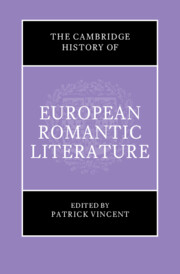Book contents
- The Cambridge History of European Romantic Literature
- The Cambridge History of European Romantic Literature
- Copyright page
- Contents
- Contributors
- Acknowledgements
- Note on the Text
- Chronology
- Introduction
- Part I Romantic Genealogies (1750–1790)
- Part II Revolution to Restoration (1790–1815)
- 7 Transcendental Revolutions
- 8 Citizens of the World
- 9 Romantic Loss, Emigration, and Exile
- 10 Women Writers’ Networks
- 11 Romantic Nationalisms
- 12 Shakespeare and Romantic Drama
- 13 Classics and Romantics
- Part III Restoration to Revolution (1815–1850)
- Further Reading
- Index
10 - Women Writers’ Networks
from Part II - Revolution to Restoration (1790–1815)
Published online by Cambridge University Press: 10 January 2024
- The Cambridge History of European Romantic Literature
- The Cambridge History of European Romantic Literature
- Copyright page
- Contents
- Contributors
- Acknowledgements
- Note on the Text
- Chronology
- Introduction
- Part I Romantic Genealogies (1750–1790)
- Part II Revolution to Restoration (1790–1815)
- 7 Transcendental Revolutions
- 8 Citizens of the World
- 9 Romantic Loss, Emigration, and Exile
- 10 Women Writers’ Networks
- 11 Romantic Nationalisms
- 12 Shakespeare and Romantic Drama
- 13 Classics and Romantics
- Part III Restoration to Revolution (1815–1850)
- Further Reading
- Index
Summary
Translation plays a significant role in Chapter Ten, which maps out women writers’ contributions to a transnational European culture, focussing on British and French fiction. Although not exclusive to the Romantic period, connections between literary women were particularly productive. If Staël served as an important model, other influential women whose lives and works complicate notions of a distinct national literature also contributed to an international Romantic culture, including Brun, Genlis, Charrière, and Krudener. Popular genres that engaged with the foreign in the 1790s included émigré novels and travel writing. Women also participated in the public sphere through the unfairly trivialised salon culture. After reviewing a number of salons, including those of Albrizzi, von Kurland, Varnhagen, Moira, and the Hollands, the chapter then explores female contributions to education theory, including Madame de Genlis’s British legacy; women’s place in the novel market, contextualising Austen by placing her side by side with two little known novelists, Mary Charlton and Elizabeth Meeke; female translations as important forms of cultural mediation, particularly those of Isabel de Montolieu; and, finally, female-edited or -authored periodicals, concluding with Sarah Harriet Burney and her possible translation of Feijoo’s defence of women.
Keywords
- Type
- Chapter
- Information
- The Cambridge History of European Romantic Literature , pp. 319 - 351Publisher: Cambridge University PressPrint publication year: 2023
- 1
- Cited by



